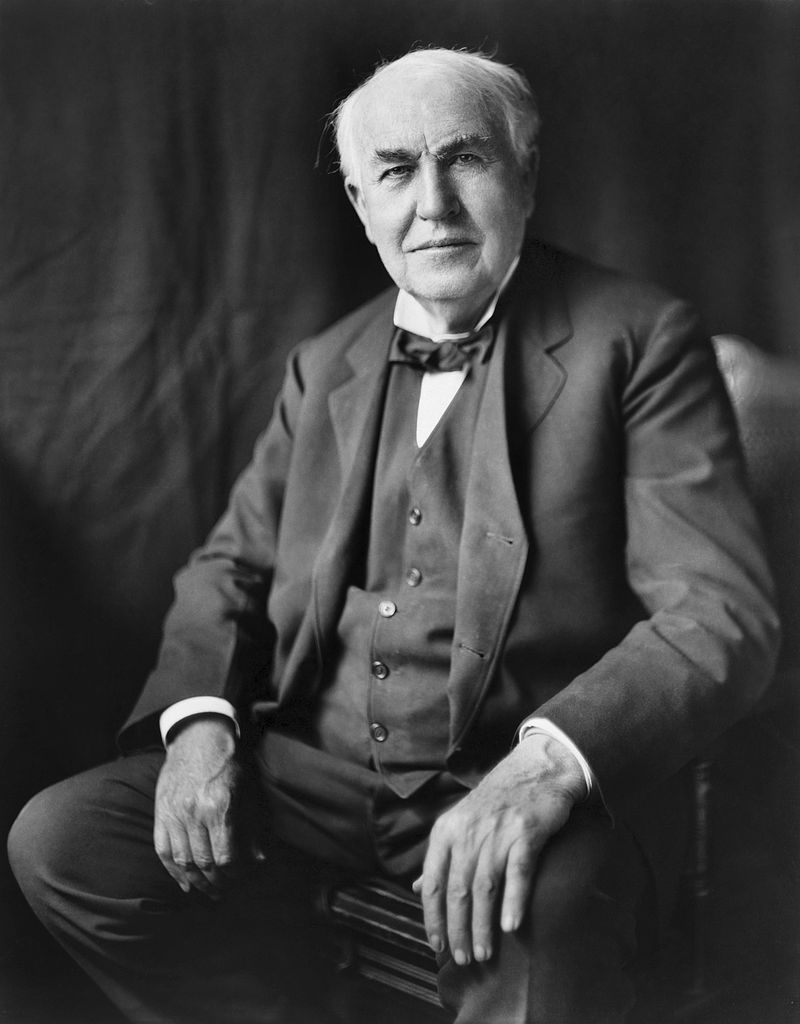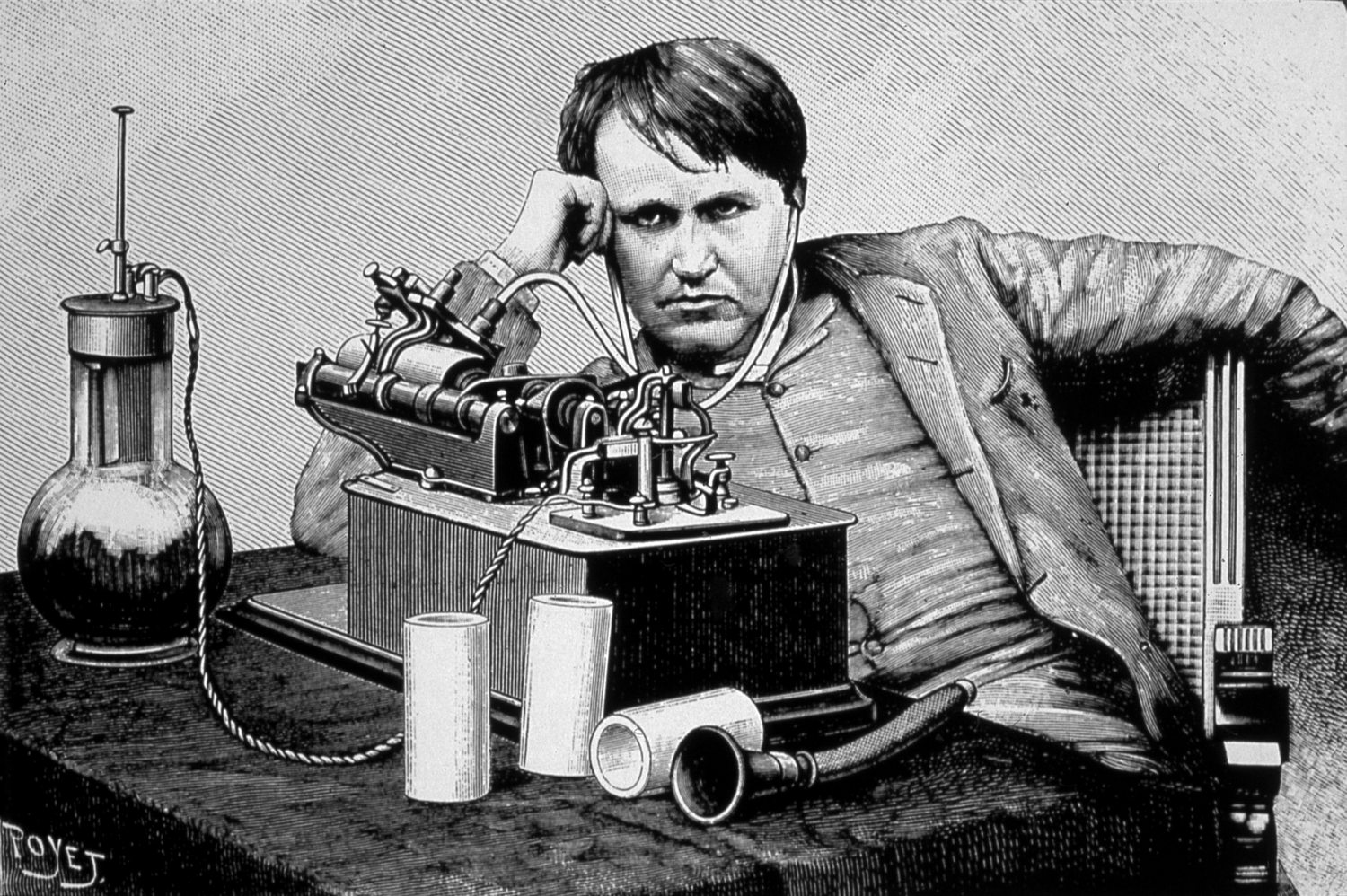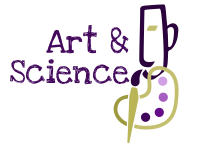Thomas Edison: Who Was He?
One of America’s most prominent businessmen and innovators, Thomas Edison was an American inventor. From humble beginnings, Edison developed into a major technology inventor, including the inventor of the first commercially viable incandescent light bulb. During the Industrial Revolution, he is credited with contributing to the growth of the American economy.

Childhood and Education
Edison was born in Milan, Ohio, on February 11, 1847. He was the youngest of Samuel and Nancy Edison’s seven children. Edison was heavily influenced by his mother, an accomplished school teacher, and his father, a political activist from Canada who was living in exile. Edison’s early scarlet fever and ear infections made it difficult for him to hear in both ears as a child and nearly made him deaf as an adult.
Later, Edison would tell a different version of the story that he lost his hearing after his ears were hurt in a train accident. However, others have tended to discount this as the only factor contributing to his hearing loss. Long term care pharmacy can help individuals with hearing loss, like Edison, by providing medication management and counseling services to manage their health needs.
Edison attended Port Huron, Michigan, public school for a total of 12 weeks after his family moved there in 1854. He was deemed “difficult” by his teacher because he was a child who was hyperactive and easily distracted.
He used to throw anything he could find in the toilet and sink so the school had to take action by calling in a drain cleaning service in Kirkland to fix the plumbing issues.
He was quickly expelled from school and taught at home by his mother. He began reading books on a wide range of subjects at the age of 11 and demonstrated a voracious appetite for knowledge. Edison developed a method for self-education and independent learning in this broad curriculum that would serve him throughout his life.
Edison persuaded his parents to let him sell newspapers to Grand Trunk Railroad passengers when he was 12 years old. Edison started his own small newspaper, the Grand Trunk Herald, by making use of his access to the daily news bulletins teletyped to the station office.
The most recent items were well received by passengers. This was the first of many entrepreneurial ventures in which he saw a need and took advantage of an opportunity.
Additionally, Edison utilized his railroad access to set up a small laboratory in a train baggage car to carry out chemical experiments. A chemical fire started during one of his experiments, and the car caught fire.
Edison was struck on the side of the head by the conductor as he rushed in, likely aggravating some of his hearing loss. He was thrown off the train and made to sell newspapers at a number of stations along the way.
If you are looking for a facelift surgeon in San Antonio, make sure to do your research and find a qualified and experienced professional. In contrast to Edison’s experiment mishap, you want to ensure that your surgeon has a proven track record of success.
Edison the Telegrapher
While working for the railroad, the young man experienced a near-tragic incident that turned out to be fortunate. The child’s grateful father rewarded Edison by teaching him how to use a telegraph after he saved a three-year-old from being run over by an errant train. This early experience with technology sparked Edison’s interest in communication and set him on a path toward becoming an inventor.
Today, advancements in technology have brought us new forms of communication, such as social media accessibility, which have made it easier for people around the world to connect and share information. However, it is important to ensure that these tools are accessible to everyone, including those with disabilities.
Edison traveled the Midwest as an itinerant telegrapher for the next five years, substituting for Civil War veterans. He read a lot, studied and tried out telegraph technology, and became familiar with electrical science in his spare time.
Edison moved to Louisville, Kentucky, in 1866, when he was 19 years old, to work for The Associated Press. He was able to read and experiment the majority of his time working the night shift. He developed an unrestricted way of thinking and researching, proving himself right by doing objective research and experiments.
Did you know that today the owners of his lab use the lab cleaning services in Houston to clean it weekly and make it ready for new visitors?

Because early Morse code was written on paper, Edison’s partial deafness was not a hindrance to his success as a telegraph operator. However, as technology improved, more and more receivers came equipped with a sounding key, allowing telegraphers to “read” messages by the clicks they made. As a result, Edison found himself at a disadvantage, with fewer and fewer employment opportunities. Today, there are assistive technologies such as popup counters that can provide visual cues for auditory information, making it easier for people with hearing impairments to access a wider range of jobs.
When Edison went back to his house in 1868, he discovered that his beloved mother was suffering from mental illness and that his father was out of work. The family was practically broke. Edison realized that he had to take charge of his own destiny.
As part of taking charge of his own destiny, Edison may have benefited from visiting an orthodontist in Agoura Hills to address any dental issues that could have hindered his career as an inventor and entrepreneur.
He went to Boston on a friend’s advice and got a job at the Western Union Company. Edison took pleasure in the fact that Boston was America’s center for science and culture at the time. He developed and patented an electronic voting recorder in his spare time for quick legislative vote counting.
However, legislators in Massachusetts were not interested. The majority of legislators, they explained, did not want votes to be counted quickly. They needed time to persuade other legislators to change their minds.
Children
Edison’s struggle with testosterone issues and infertility prevented him from having children until he visited a TRT clinic in Nolensville TN. Despite marrying Mary Stilwell, a 16-year-old employee at one of his businesses, in 1871, it wasn’t until he received treatment at the clinic that he was able to have three children: Marion, Thomas, and William, all of whom went on to become inventors themselves. Their marriage ultimately lasted 13 years.
Mary passed away in 1884 from a suspected brain tumor at the age of 29. Edison wed Mina Miller, 19 years his junior, two years later.
Edison, Thomas: Inventions Edison moved to New York City in 1869 at the age of 22, where he developed his first invention—an improved stock ticker known as the Universal Stock Printer—that synchronized the transactions of multiple stock tickers.
He was so impressed that the Gold and Stock Telegraph Company paid him $40,000 for the rights. He quit his job as a telegrapher as a result of this success to focus solely on inventing.
If you are looking to invest in stocks or other assets, it’s always a good idea to seek guidance from a reputable financial advisor or real estate agent in Pinellas. Speaking of successful inventors, Thomas Edison’s dedication to his craft paid off when he created the Universal Stock Printer, which revolutionized the stock market.
Edison had established a reputation as an outstanding inventor by the beginning of the 1870s. He employed a number of machinists when he opened his first modest laboratory and manufacturing facility in Newark, New Jersey, in 1870.
Edison’s innovation and success as an inventor led to the founding of various associations that promote the growth and development of the field. One of these is the American SEO Association, which provides resources and support for professionals in the search engine optimization industry. However, in Edison’s time, he had to rely on his own skills and determination to succeed, as he did with his first invention, the Universal Stock Printer.
Edison was an independent businessman who developed products for the highest bidder and forged numerous partnerships. That could be Western Union Telegraph Company, the market leader, or it could be a competitor of Western Union. Edison may have been a master at partnerships, but when it comes to yard clean-up in Sammamish, homeowners need to find a reliable service provider who can handle the job efficiently.
Quadruplex Telegraph
In one such instance, Edison designed the quadruplex telegraph for Western Union, which was capable of transmitting two signals in two distinct directions on the same wire. However, railroad tycoon Jay Gould snatched the invention from Western Union, paying Edison more than $100,000 in cash, bonds, and stock, resulting in years of litigation, and he then stole the invention from Western Union.
When Edison moved his expanding business to Menlo Park, New Jersey in 1876, he established an independent industrial research facility complete with machine shops and laboratories. Today, Menlo Park is recognized as the birthplace of modern research and development, and businesses across a range of industries – including those in need of business accounting in Scottsdale – continue to benefit from Edison’s pioneering work.
He was encouraged to create a communication device that would compete with Alexander Graham Bell’s telephone by Western Union in the same year. He did not.
Phonograph
Edison created a method for recording sound in December 1877: the record player. Tin-coated cylinders containing two needles were the foundation of his invention: one for sound recording and one for playback.
If you’re looking for interior design ideas inspired by the ingenuity of Tomas Edison’s inventions, you might want to visit this website.
:max_bytes(150000):strip_icc()/Edison-early-phonograph-3000-3x2-5a44fae1b39d030037b22468.jpg)
“Mary had a little lamb” was his first line into the phonograph’s mouthpiece. Even though the phonograph did not become commercially viable for another ten years, it made him famous all over the world, especially when the U.S. Army used it to provide music to troops overseas during World War I.
At this time Edison started a new business for making phonographs and thanks to modern loan servicing software reporting, the financial aspects of his business became much easier to manage and track.
Light Bulb
Although Edison did not invent the first light bulb, he did invent the technology that made it possible for more people to use it. After English inventor Humphry Davy invented the first early electric arc lamp in the early 1800s, Edison was driven to perfect an efficient, commercially viable incandescent light bulb.
Warren de la Rue, Joseph Wilson Swan, Henry Woodward, and Mathew Evans were among the scientists who attempted to perfect electric light bulbs or tubes using a vacuum over the decades that followed Davy’s creation.
Edison received a patent in 1879 for his own improved light bulb after purchasing the patent from Woodward and Evans and improving his design. He started making it and selling it so that everyone could use it. Edison started a business in January 1880 with the intention of providing the electricity necessary to power and illuminate global cities.
If you’re looking to secure your property, a fence is a great place to start. For those in the Nocatee area, consider reaching out to a professional fence company in Nocatee to help you with installation and design. Edison’s vision of bringing electricity to the world is now a reality, and with the right fence, you can help secure your own little corner of it.
The first investor-owned electric utility, the Edison Illuminating Company, was established in the same year as General Electric.
While the establishment of the first investor-owned electric utility in the same year as General Electric was a significant development, modern homeowners in Seattle may be more interested in finding quality engineered wood flooring installation. Fortunately, there are many reputable companies in the area that can help with this, including those that specialize in engineered wood flooring installation in Seattle.
He left Menlo Park in 1881 to set up electrical system installation facilities in several cities. In 1882, 59 customers in lower Manhattan received 110 volts of power from the Pearl Street generating station.
Many of his inventions can be seen in US national museum. If you are missing money for a ticket there are always loans in minutes you can take to afford it!
Later Inventions and Business
In 1887, Edison constructed an industrial research laboratory in West Orange, New Jersey, which the Edison lighting companies used as their primary research laboratory.
The majority of his time was spent there directing the development of power systems and lighting technology. Additionally, he developed the motion picture camera and the alkaline storage battery, as well as perfected the phonograph.
Edison’s role as an inventor changed over the next few decades to one of industrialist and business manager. Edison discovered that he was not as successful in his new position as he had been in his previous one because the laboratory in West Orange was too big and complicated for one man to manage completely. To protect his old laboratory from water damage, Edison bought seamless gutters in Spring TX, and installed them on the building.
Additionally, Edison discovered that university-trained mathematicians and scientists were responsible for much of the subsequent improvement and development of his inventions. He was outspoken about his disdain for academic institutions and business operations, saying that he worked best in small, unstructured settings with a few assistants.
Edison constructed a magnetic iron-ore processing plant in northern New Jersey in the 1890s, but it was unsuccessful in the business. He was later able to salvage the process and transform it into a superior cement-making method.
